William Cowper visits a woody riverbank by which he passed many pleasant childhood days… to find it irrevocably changed.
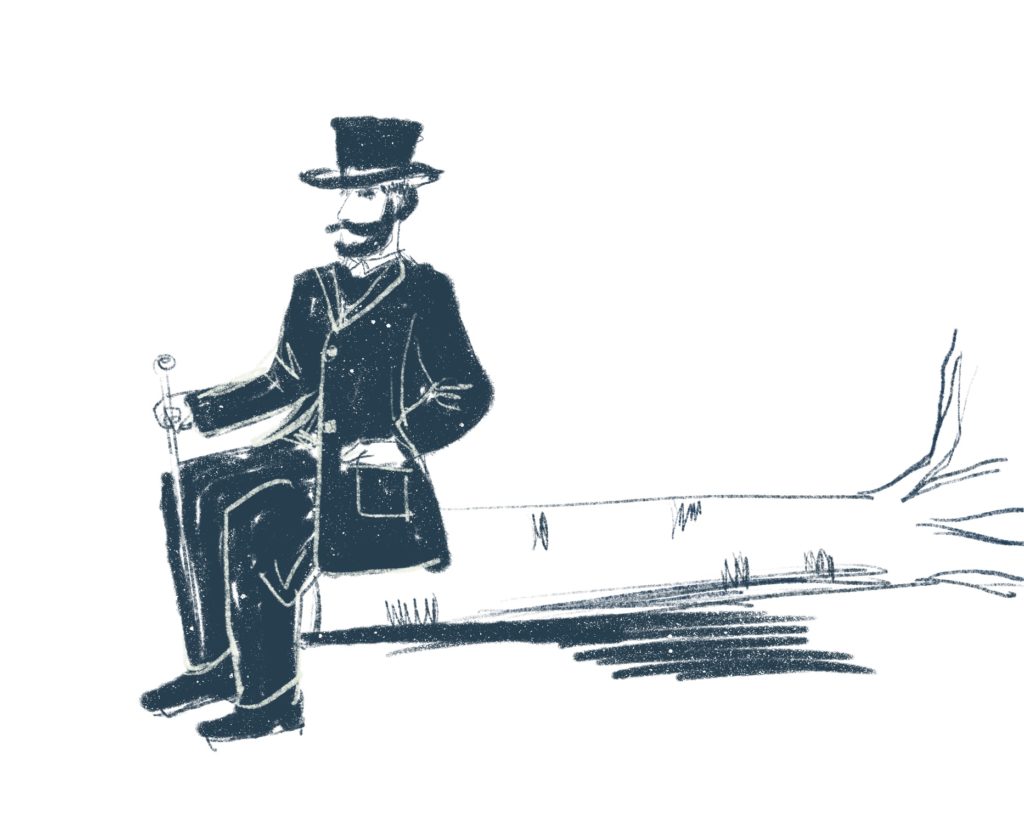
“The best modern poet.”
Samuel Taylor Coleridge
Have you ever owned something that’s not worth much but has sentimental value: an old photograph, faded and worn, or a piece of jewellery passed down to you through your family? Or do you have special memories attached to a specific place? You may have grown up in a house you remember fondly, sought refuge in that certain basement or barn, walked down that particular path. How would you feel if you lost that item? How would you feel if you returned to that particular place to find it changed, or gone? For the speaker in William Cowper’s poem, that place is a poplar-field alongside the river Ouse, (the Great Ouse that rises in Northamptonshire and passes by Olney, where Cowper lived). That item is a row of poplar trees, the poem’s most important symbol, that he used to sit under to find shade and enjoy the tranquillity of the countryside.
The poplars are felled, farewell to the shade
And the whispering sound of the cool colonnade,
The winds play no longer, and sing in the leaves,
Nor Ouse on his bosom their image receives.
Twelve years have elapsed since I last took a view
Of my favourite field and the bank where they grew,
And now in the grass behold they are laid,
And my tree is a seat that once lent me a shade.
The blackbird has fled to another retreat
Where the hazels afford him a screen from the heat,
And the scene where his melody charmed me before,
Resounds with his sweet flowing ditty no more.
My fugitive years are all hasting away,
And I must ere long lie as lowly as they,
With a turf on my breast, and a stone at my head,
Ere another such grove will arise in its stead.
‘Tis a sight to engage me if anything can,
To muse on the perishing pleasures of man;
Though his life be a dream, his enjoyments, I see,
Have a being less durable even than he.
The poem begins with a wistful memory; taking refuge from the sun in the cool shade under the trees, Cowper used to listen to the songs (melody, ditty) of blackbirds who nested in the poplars, and the sound of the wind in the leaves, which had its own kind of music. Twelve years have passed (elapsed since I last took a view) and he has returned to the poplar-field… to find the trees cut down and seemingly abandoned to lie around in the grass; he even uses one as a seat while he contemplates this upsetting scene. The poem has an autobiographical origin: at some time in or before 1784, Cowper was escorting his friend Lady Austen to the poplar grove site of which he was fond, to find the trees cut down. He later composed this poem as lyrics set to one of her favourite tunes. This anecdote goes some way towards explaining the peculiar contrast of melancholy thoughts (the poem is concerned with sudden absences, the passing of time and the inevitability of death) with the light, musical form.
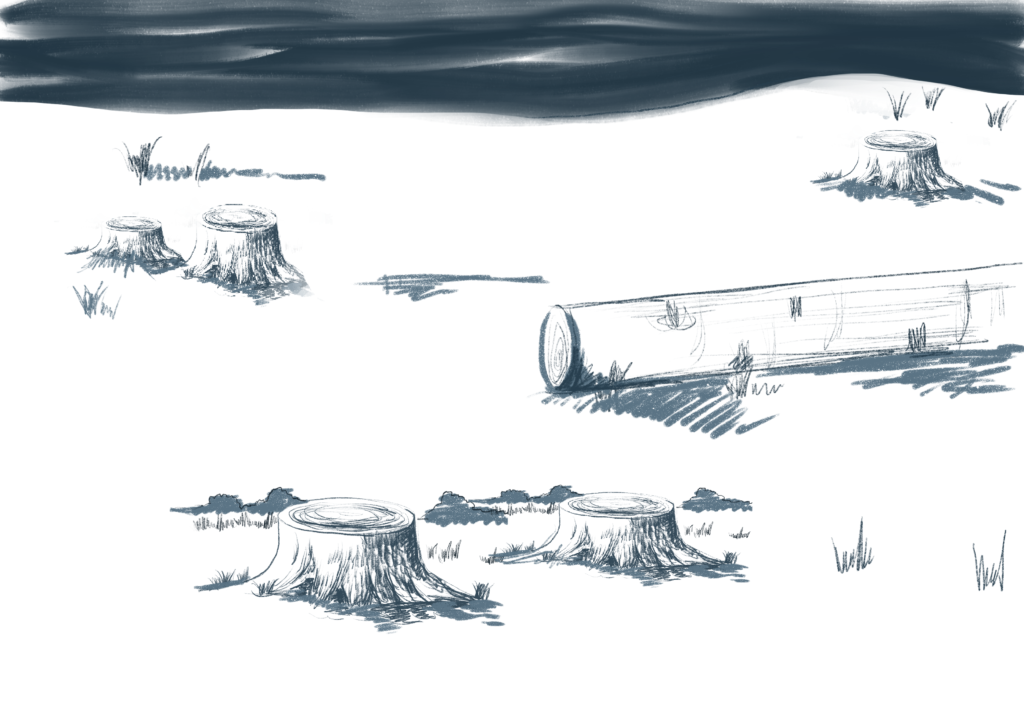
I must admit that, when I read this poem for the first time, I had conflicting reactions towards the speaker himself. Initially I felt sorry for him; I read the poem nostalgically and shared his genuine distress that all the things he used to enjoy had vanished. Absences are felt keenly by the speaker, this feeling communicated effectively through a series of negations. The speaker reminisces and summons memories from the past; he shows them to us, then negates them so we can feel his regret in their passing. You can easily pair almost every noun in the poem with its negation: ‘the poplars are felled’; ‘the winds play no longer’; ‘nor Ouse’ (a river); ‘twelve years have elapsed’; ‘the blackbird has fled’; ‘sweet flowing ditty no more’; ‘my fugitive years are all hasting away’. Only once the poem approaches its end, and the poet begins to contemplate death, do the images become permanent and lasting: neither the turf on my breast nor the stone at my head are negated. In this way, Cowper brings us around to his (quite depressing) way of thinking – the only permanent things in the world are the objects that mark our deaths.
So why choose the song form to express these thoughts? Wouldn’t something like a sonnet have been more appropriate? A really interesting idea put forward by B. Hutchings of the Cowper and Newton Museum (yes, really!) is that the poem presents man and nature living in a harmonious relationship. He argues that the blackbird “is the equivalent of the poet” producing pleasing sounds for others to enjoy. Hutchings locates the polysemic word ditty as the point where the natural and human worlds converse: ditty means both ‘birdsong’ and ‘short poem.’ It’s as if, through reproduction of the blackbird’s melody, Cowper makes his own tribute song to the bird whose song he used to enjoy so much. The association of his own grave (turf… stone) with the site of the vanished poplar grove is the extreme expression of this harmony.
However, in my mind’s ear, the more I read the more the tone changed from nostalgic and wistful to self-indulgent and pitiful. I asked, does he lament the passing of the blackbird for the blackbird’s sake, or for his own? In the final stanza (more of which later) he calls natural things ‘enjoyments’ and ‘pleasures’ which implies their primary function is to provide people with distraction. Look back through the poem and notice the frequent references to me, my and I. There’s a lot for a poem ostensibly about a poplar-field: my tree is a seat that once lent me a shade contains two in itself. What’s more, in the first stanza he presents a picture of the river Ouse that reflects the overhanging trees like a mirror: might this suggest a little narcissism? The personification of the Ouse (nor Ouse on his bosom) plays into this point too, as if things in the natural world only have value if framed in human terms. Similarly, in stanza four, the speaker makes a direct comparison of himself with the trees, conflating the felling of the poplars with his own approaching demise (in fact Cowper himself was to live another 15 years, making this worry seem a little premature):
My fugitive years are all hasting away,
And I must ere long lie as lowly as they,
Diction points to the way time seems to move quicker and quicker the less you have of it: hasting away. To really hammer home this worry, Cowper employs liquid alliteration (L/W/R) in the second line to speed the pace – read the line aloud and feel the Ls fairly skipping off your tongue – and make it feel like time is actually running away from him. Despite the beauty of the poetry though, I can’t help but feel the speaker is more concerned about himself than the devastation he sees in the world around him. I’m quite happy to be refuted here, and you may feel that the me, my, I referents indicate ownership over his memories rather than the natural world itself. I understand how a person can feel a sense of ownership over a place in which he or she may have spent long, happy, formative years; you become so used to certain scenery that you feel it belongs to you.
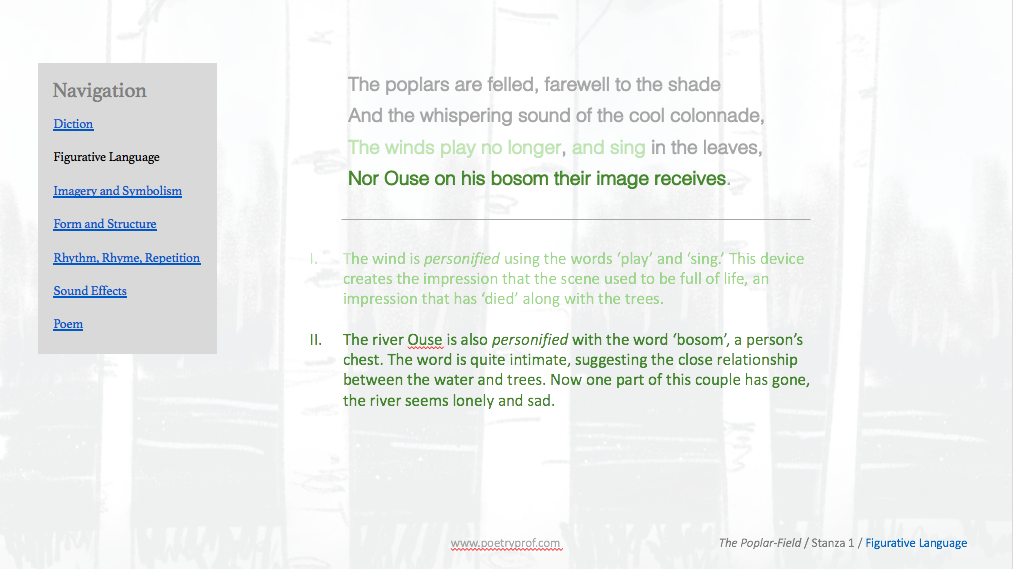
Where the poem excels for me is in its mastery of form: the speaker’s principal worry is the irreversible passage of time, therefore all the structural features of the poem combine to propel your eyes forward. For instance, each stanza (except the last) begins with a couplet that enjambs from the first to second line. From there the lines are linked with the weakest end-stop mark, a comma, before concluding in a full stop, so the verse flows quickly from beginning to end. Like a film-maker putting together a ‘Director’s Cut’ years after the release of a flawed masterpiece, Cowper later extensively revised and edited his poem. One reason for the editorial changes was that Cowper perhaps rushed to get his poem out in print (it was published by The Gentleman’s Magazine, a widely read periodical of the time) so he was not satisfied with certain details. For example, he changed the final stanza from its original version, reproduced here:
1785 Version
The change both my heart and my fancy employs;
I reflect on the frailty of man and his joys.
Short-liv’d as we are, yet our pleasures, we see,
Have a still shorter date, and die sooner than we.
In truth, these alterations made little difference to either the ‘moral’ or the effect of the meter, which is to drive the rhythm forward. Anapaests (de-de-DUM) are adept at creating that feeling of forward motion as the first two syllables are light and quick. Iambs (de-DUM) can produce a similar effect through their association with the rhythm of a heartbeat or ticking clocks, although it is less direct. The later version relies more on anapaests, though the combination of both produces a similar feeling.
The musicality of the poem (that blackbird tribute song) comes from the interplay of metre and sound patterns, which, in turn, strongly contribute to the feeling of forward momentum: sounds from one line are picked up and repeated either in the same line or in the next. The clearest examples are in verse one, but you’ll see this twinning of sounds through the first three and a half verses if you look closely:
The poplars are felled, farewell to the shade
And the whispering sound of the cool colonnade,
The winds play no longer, and sing in the leaves,
Nor Ouse on his bosom their image receives.
The pairing up of alliterative sounds is reflected in the form of the poem: each stanza consists of one quatrain separated into two pairs of rhyming couplets. So you have two P sounds in poplars; the F/L in felled repeats instantly in farewell; cool and col- is almost an exact repetition, minus one vowel; the W/I sound of whispering is picked up in the next line when you hear the wind and so on. Occasionally, you can find sonic echoes which resonate in similar words from one verse to another: felled, field and fled being the best example; seat, sweet, sight another you might like. Of course, the AABB rhyme scheme achieves the same effect with similar word endings complementing each other perfectly from line to line. Rhyming couplets work together with the rhythm, as the expectation of a pleasing rhyme pulls your eyes to the end of each line like a magnet. There are no unexpected half rhymes or jarring sounds, nothing to break the steady forward motion of the language.
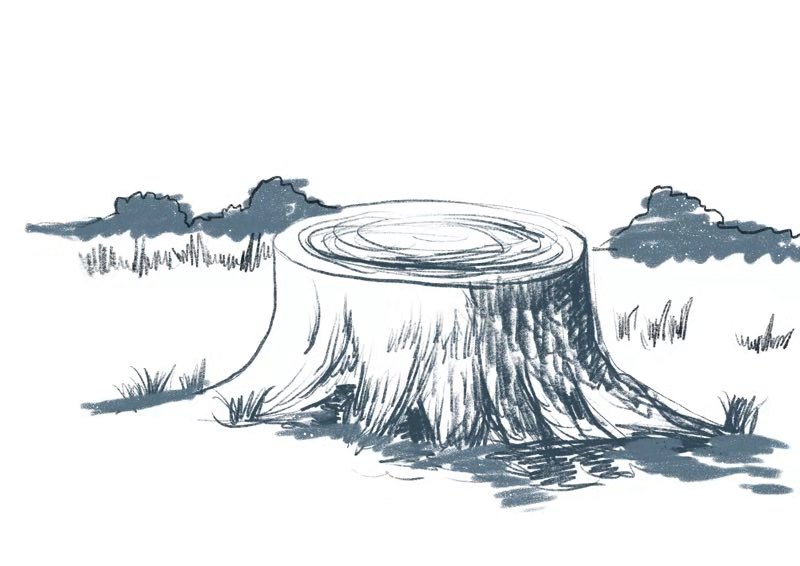
You might like to consider the idea that the pairing and twinning aspects of form convey a sense of mankind working in harmony with nature; – ask if this is really the case. Indeed, this relationship is one of the most interesting aspects of this poem and it’s well worth considering what it reveals about the late eighteenth century context (the poem was first published in 1785). Some of the diction is drawn from the language of war, as if the human and natural worlds are engaged in conflict. Field can be the staging area for a battle and screen a manoeuvre. We speak of soldiers felled in battle, like the titular poplar trees. If so, it’s a conflict that nature is losing: retreat, fled and fugitive all refer to running away. You might agree with my previous observation that the poem reduces elements of the natural world to mere adornments of the human world. For instance, the trees were lined in a ‘colonnade’, a row of columns; language that depicts them in an architectural, rather than a natural, arrangement. Too, the way the poet uses a fallen tree as a seat suggests a rather utilitarian attitude towards the field.
The tendency to treat the natural world as a plaything of the human world unfortunately mars the end of the poem, which I find problematic – to my mind, it dials the self-indulgence and pity up to eleven. Firstly, he admits that wallowing in depressing thoughts like these are the only things which can capture his interest:
‘Tis a sight to engage me if anything can,
To muse on the perishing pleasures of man;
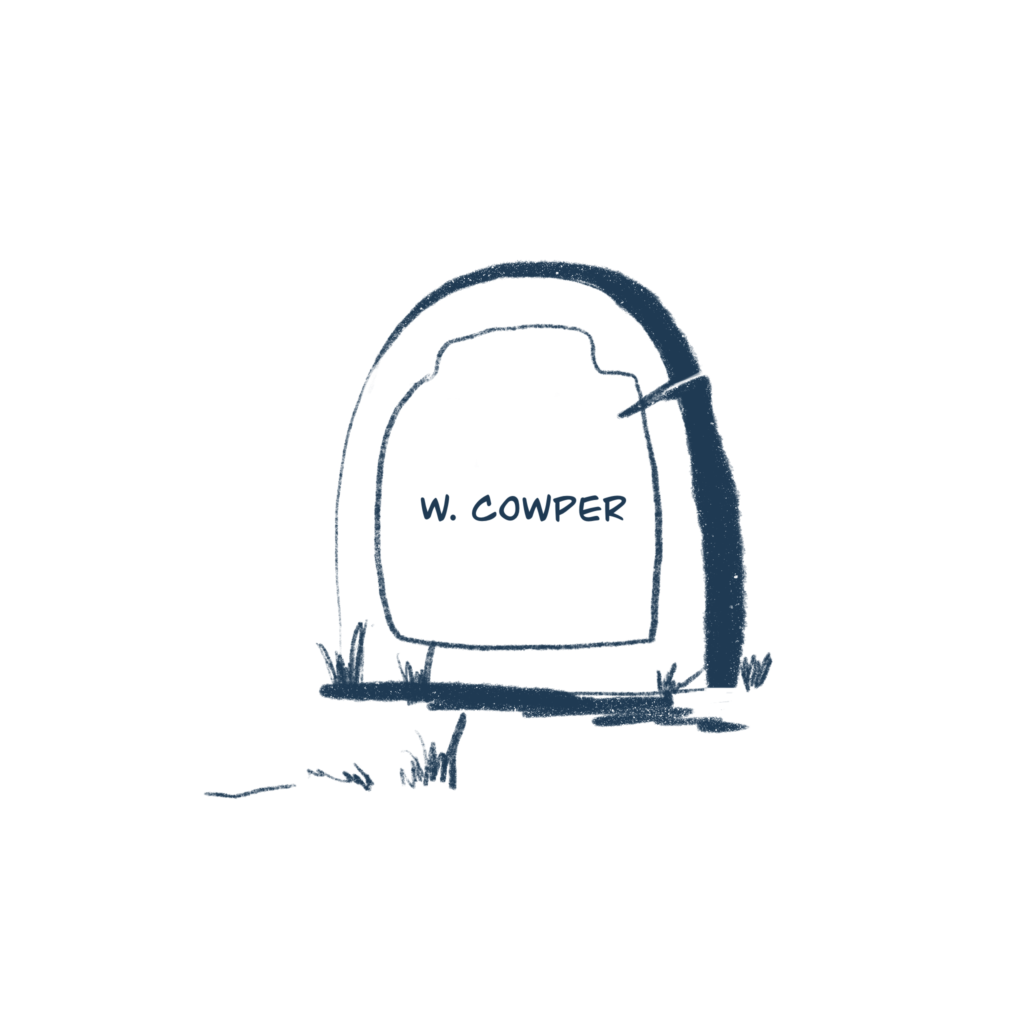
There’s definitely a touch of schadenfreude in this couplet. He admits that he finds it hard to be ‘engaged’ (interested) by anything except thoughts of the perishing pleasures of man– is he seeking comfort in a kind of ‘if I can’t be happy, at least nobody else can be happy either’ mentality? Plosive alliteration (P/B) certainly suits such an admission, as the push of air in plosive is really good at expelling strong (negative) thoughts and emotion. Look closer and see how the pattern of alliteration in the second line runs forwards and backwards (m/p/p/m). The name for this arrangement is chiastic – does it express the desire to turn back time?
Cowper concludes by delivering a moral about how life is short, and the life of things we enjoy even shorter:
Though his life be a dream, his enjoyments, I see,
Have a being less durable even than he.
Notwithstanding the twee cliché of ‘life is like a dream from which we must soon awake,’ (which was already old when Hamlet said it) this whole bit strikes me as overly anthropocentric. It might be relevant to know that in 1773 Cowper was institutionalised after he suffered a dream in which he was convinced he would suffer eternal damnation – this would certainly help explain the maudlin attitude as we reach the end of the poem.
Actually, if you read Cowper’s biography, you’ll be struck by his massive achievements over the course of his life: despite illness and self-doubt plaguing him as he got older, he kept writing until the year of his death. Given Coleridge called him “the best modern poet,” King George III praised his poem The Task and his anti-slavery poetry was quoted by Rev. Martin Luther King, he deserves to be recognised as one of the most influential poets of his time.
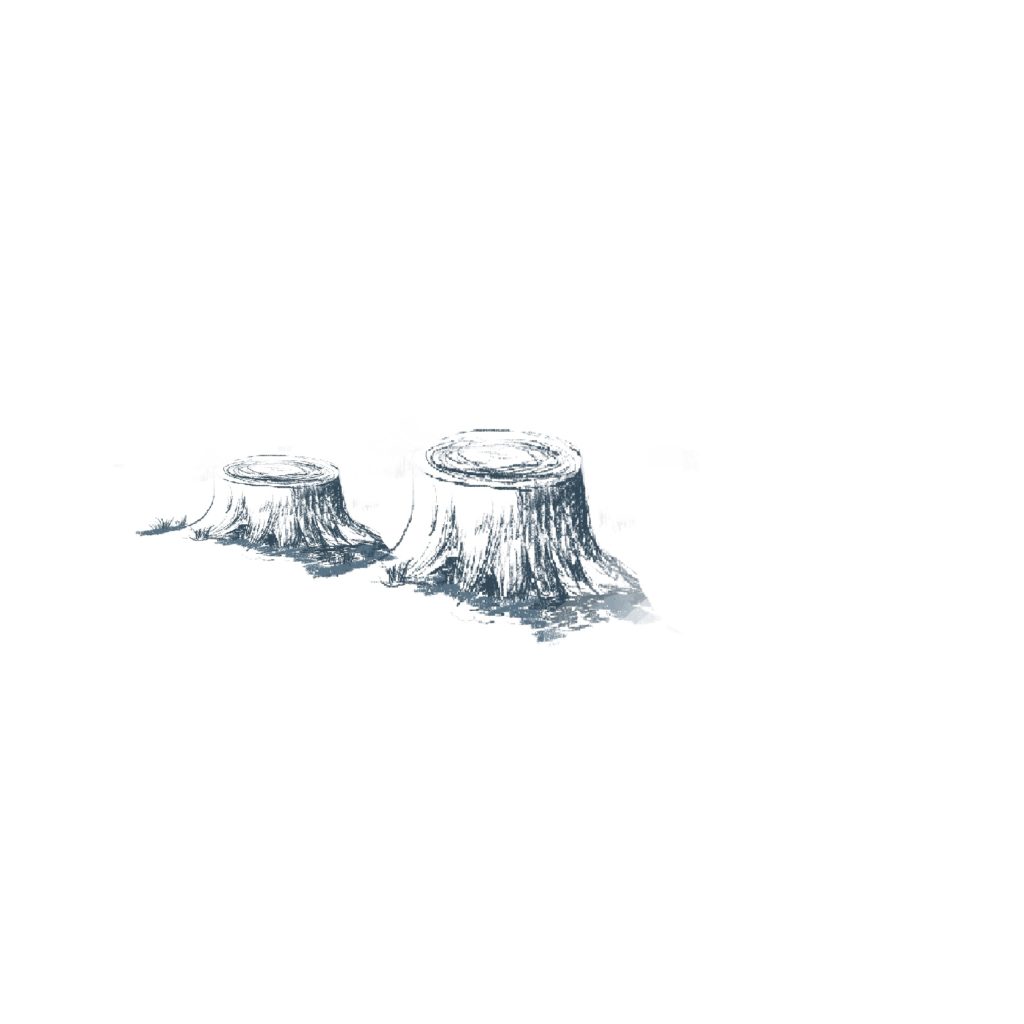
Suggested poems for comparison:
- The Trees are Down by Charlotte Mew
This poem is Mew’s reaction to the cutting down of the huge plane trees in Euston Square during the 1920s. It would make a great companion-piece to Cowper’s The Poplar-Field.
- The Castaway by William Cowper
This is one of his latest poems, completed just a year before his death. Wrestling with worsening illness and despair, Cowper describes himself as a drowning sailor.
- The Fallen Elm by John Clare
Unpublished in his lifetime, this poem is now regarded as one of John Clare’s best. It begins by telling the story of the cutting down of an elm tree near his home in Hempstead, and goes on to deliver an indictment of ‘enclosure’; the practice of fencing common land for sale to individual owners.
Additional Resources
If you are teaching or studying The Poplar-Field at school or college, or if you simply enjoyed this analysis of the poem and would like to discover more, you might like to download our bespoke study bundle for this poem. Costing only £2, the bundle includes:
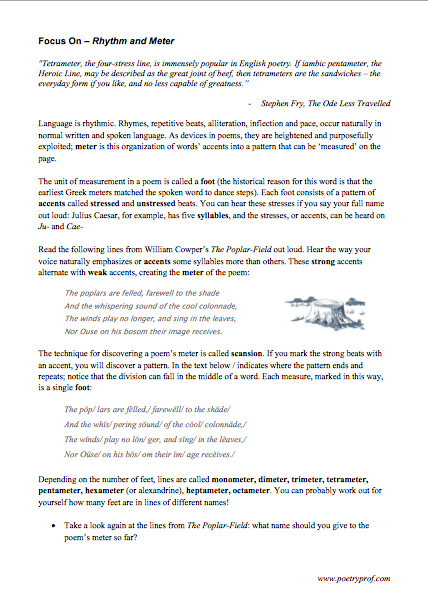
- 4 pages of activities that can be printed and folded into a booklet for use in class, at home, for self-study or revision.
- Study Questions with guidance on how to answer in full paragraphs.
- A sample Point, Evidence, Explanation paragraph for essay writing.
- An interactive and editable powerpoint, giving line-by-line analysis of all the poetic and technical features of the poem.
- An in-depth worksheet with a focus on rhythm and meter.
- A fun crossword-quiz, perfect for a recap lesson or for revision.
- 4 practice Essay Questions – and one complete model Essay Plan.
And… discuss!
We hope you enjoyed this exploration of The Poplar-Field. What do you think of our interpretation of the poem? Do you agree that the tone of Cowper’s poem is a bit too maudlin? Can you relate to the experience of loss he describes? Why not leave a comment, ask a question, or let us know your personal response to the poem in the comment section below. And, for daily nuggets of analysis and all-new illustrations, don’t forget to find and follow Poetry Prof on Instagram.
Terrific work, Doug and Alicia!
You should try and get more people to follow you on Instagram.
Moreover, do you know any other good website for sample answers for these poems?
I also need a similar site for answers on ‘a separate peace’ and Macbeth.
Regards.
Hi, thank you for your comment. Hopefully we will gather more followers as time goes on. Have you had a look inside our Study Bundles? You will find lots of help with writing answers to different essay questions, including a sample analytical paragraph to model essay writing technique, and a complete essay plan for you to follow.
Thank you again – we hope to see you back on our site soon.
Thank you for your excellent commentaries on all of these poems.
A pedantic p.s.: the River Ouse in the poem is the Great Ouse that rises in Northamptonshire and passes by Olney, where Cowper lived, rather than the Ouse in Yorkshire (there are four rivers called Ouse in England). The Hutchings article that you mention above has a link to a YouTube video with more detail.
Hi Lucy – thank you for your correction. I’m a Somerset lad, so a bit hazy on geography at that end of the country. I’ll update the blog to include this great information. Thank you so much :o)